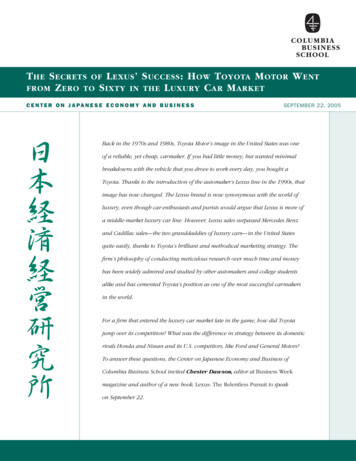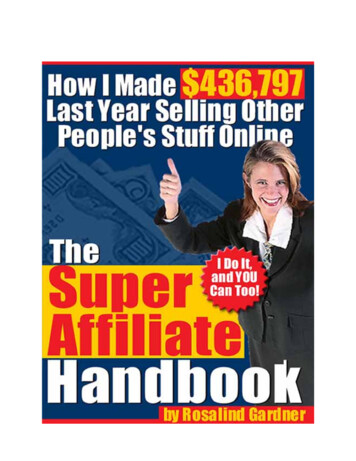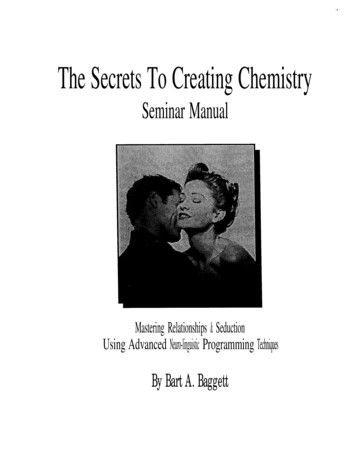
Transcription
T HE S ECRETS OF L EXUS ’ S UCCESS : H OW T OYOTA M OTOR W ENTFROM Z ERO TO S IXTY IN THE L UXURY C AR M ARKETC E N T E R O N J A PA N E S E E C O N O M Y A N D B U S I N E S SSEPTEMBER 22, 2005Back in the 1970s and 1980s, Toyota Motor’s image in the United States was oneof a reliable, yet cheap, carmaker. If you had little money, but wanted minimalbreakdowns with the vehicle that you drove to work every day, you bought aToyota. Thanks to the introduction of the automaker’s Lexus line in the 1990s, thatimage has now changed. The Lexus brand is now synonymous with the world ofluxury, even though car enthusiasts and purists would argue that Lexus is more ofa middle-market luxury car line. However, Lexus sales surpassed Mercedes Benzand Cadillac sales—the two granddaddies of luxury cars—in the United Statesquite easily, thanks to Toyota’s brilliant and methodical marketing strategy. Thefirm’s philosophy of conducting meticulous research over much time and moneyhas been widely admired and studied by other automakers and college studentsalike and has cemented Toyota’s position as one of the most successful carmakersin the world.For a firm that entered the luxury car market late in the game, how did Toyotajump over its competition? What was the difference in strategy between its domesticrivals Honda and Nissan and its U.S. competitors, like Ford and General Motors?To answer these questions, the Center on Japanese Economy and Business ofColumbia Business School invited Chester Dawson, editor at Business Weekmagazine and author of a new book, Lexus: The Relentless Pursuit to speakon September 22.
the Board of Directors behaved,leaked to him, oral interviews,operated, and utilized the infor-and other information. I nowmation they were gathering,turn it over to him.because they decided that theydidn’t need people like metalking to them about Japan’srole in the world. What theyHUGH PATRICKDirector, Center on JapaneseEconomy and Business,Columbia Business Schoolneeded were engineers andThere are now three win-is the best automobile companyning Japanese automobilein the world, certainly theother strategic planners, whichwas graduation in and of itself.My personal view is that Toyotamanufacturers of note: Toyota,most profitable by far. I thinkHonda, and—now that it’s beenits profits last year equaled therestructured and revitalized—sum of Ford, General Motors,Nissan. In a global sense,and Chrysler.Toyota is the most remarkableI’m delighted to introduceof these. I first visited Toyota inChester Dawson because hethe mid-1980s, and back then,knows a great deal about theI had the sense that I was meet-automobile industry and abouting with a somewhat parochialLexus. He is the Asian, European,group of people who didn’tand Emerging Markets Editor atknow a great deal about theBusiness Week, and he workedrest of the world except thatin Japan for ten years. Beforethey were selling a whole lotthat, he did an undergraduateof cars. In 1980, Toyota didn’tyear in Japan. I guess that’shave any factories outsidewhere he got hooked and whyJapan, but it was exportinghe brings a lot of practicala third to a half of its output.experience from working inOver time, it has grown intoJapan. He’s written extensivelythis global powerhouse. Youon the Japanese automobilecan’t say today that Toyota isindustry, although his focus isa parochial organization by anymostly in finance, securities,means. In 1980, most of theirmarkets, and banks.team didn’t know any English.Lexus is an example of aMost of them had not workednew automobile luxury marketabroad. That’s no longer true.that Toyota has developed quiteToyota has quick learners,successfully. Mr. Dawson hasand we see that it has beenwritten, Lexus, The Relentlessinvolved in an incremental,Pursuit, a fascinating book thatcontinuous improvementutilizes a combination of inter-process. We saw it in the waynal documents that somebody2The Secrets of Lexus’ SuccessCHESTER DAWSONEditor, Business WeekThank you for that warmintroduction, ProfessorPatrick. I am here today to talkabout Lexus and what madethat brand such a success forToyota. Some history is in orderon how this brand came to be.Lexus was born out of a brainstorming session of Toyota’schiefs on a hot August day inthe summer of 1983. At thatpoint, even the most zealousproponents of a Japanese luxury car program could scarcelyimagine what Toyota wouldunleash upon the market adecade later. Lexus has grownfrom a little more than an oxymoron when it debuted in1989. Think of it—a Japaneseluxury car! It was laughable atthe time; now it is the leadingluxury brand in the U.S. for thepast five years running. Thatmeans Lexus has greater salesthan Cadillac, Lincoln, BMW,and, yes, that former benchmark of luxury, Mercedes Benz.Toyota has quicklearners. We seethat it has beeninvolved inan incremental,continuousimprovementprocess.—Hugh Patrick
Sales rose from less than 20,000those prescient remarks byunits in the first year to justsaying, “Getting the Lexus outsanctions. You may not recallunder 300,000 units last year,of Toyota, whose forte is rollingthis, but in the 1980s, thereup 10 percent over the previ-out wheels for the millions, iswas a lot of pressure on theous year. There are more thanlike producing Beef WellingtonJapanese to adopt Voluntarya million Lexus vehicles beingat McDonalds.” But before I goExport Restraints because theredriven on the roads of Americainto the details of how Toyotawere so many cars floodingtoday. That’s a testament notsucceeded in making Beefonto the U.S. market. In fact,only to their marketability, butWellington for the masses, I’llthere was a period when therealso to their durability. Youspeak briefly about why Lexuswas an informal quota on howstill see a lot of the very firstwas created by Toyota in themany Japanese cars couldmodels being driven today.first place. With that insight, it’scome in. Thus, if you’re think-Lexus is synonymous with theeasier to grasp the marketinging about how to grow theword “luxury,” from which itsuccess that came with these cars.products of a company at awas derived. Like Kleenex, it’sTo keep the loyalistswho’d supportedthe brand’s growththrough the 1970sand 1980s, Toyotafelt it needed to goto a new level.—Chester DawsonThere were a lot of reasonsAnother reason was tradetime when exports are underanother “X” word that’s crossedfor the creation of Lexus,strict limitations, one way to gothe divide between corporateincluding that it was a logicalis value, rather than volume.jargon and into the popular lex-next step for Toyota. By theFrom quantity, Toyota went toicon. These days, people thinkearly 1980s, it had cleared an 8quality. If they could sell justnothing of describing things aspercent global marketing share.as many or even fewer cars but“the Lexus of espresso makers”The types of cars it was mostcharge more per vehicle, thenor, mundanely, “the Lexus ofsuccessful with were initiallyit was a way to clear the hurdlevacuum cleaners.” Recently,the sub-compact and compactfor profit growth. And ToyotaI met a young woman whosecars, or the Tercels and Corollaswas keeping up with thefirst name was, yes, Lexus. Inof the 1970s, which were some-Joneses. Nissan was developingfact, the Wall Street Journalthing the baby boomers cameits own luxury line calledhas reported that Lexus hasto feel that they had discov-Infiniti. Honda had its Acura,surpassed Mercedes and Chanelered. As the baby boomerswhich debuted three yearsas the most popular luxurymoved past college, frombefore Lexus in 1986. Toyotabrand name for newborns.single, first-time car buyers, tocertainly didn’t want to be leftNow THAT’s power branding!getting married and having set-behind. When Toyota first cametled careers, they were buyingto the U.S. in the late 1950s,of Business Week, I will tip mymid-sized cars like Camrys.they tried to sell their Crownhat to Fortune, a rival publica-However, by the early 1980s,line. They actually opened up ation. Fortune wrote somethingthey were leaving the brandshowroom in Beverly Hills withwith great insight fifteen yearsentirely because Toyota didn’ta lot of fanfare, but the car wasago, in an article titled, “Thehave an equivalent to a Jeepso underpowered that it wasInside Tale of How Lexus CameCherokee or a BMW 3 Series.quickly dismissed by the autointo Being Is Rich in LessonsTo keep the loyalists who’dpress. Toyota had to turn tail andfor Anyone Who Yearns tosupported the brand’s growthhead back to Japan. It wasn’tDevelop Up-Market Products.”through the 1970s and 1980s,until twenty years later thatOf course, Fortune doesn’tToyota felt it needed to go tothey came up with a productalways get it right. It hedgeda new level.that could really stand up toEven though I’m an employeeSeptember 22, 20053
the competition in the U.S.S Class Mercedes or the 7 Seriestimes the amount spent on aManagement was pretty consis-BMW, with roughly a 30,000usual model in the develop-tent during that time, and theresavings. For people who weren’tment phase and seven timeswas little turnover. The Toyodainterested in brand value, thatthe number of dedicatedfamily retained hold of thewasn’t important. But for peo-employees. Quite an effortcompany, and they wanted tople who were interested inwent into this. Just to put thatshow technology that competedgetting a good deal, of whichinto some perspective, thewith the very best in auto mak-there are quite a few, Toyotanumber of people that Toyotaing. Going to luxury automobileshit the market dead on.had assigned to work on thewas one way to do that.Lastly, they sensed a vacuum.What was the secret?first Lexus in the 1980s was aThere’s no magic formula forlittle over half the number thatThere was an opportunity forhow they did it. Without anyBoeing assigned to build itsToyota to do something thatdoubt, Madison Avenue had afirst 777 jumbo jet in the 1990s.it had always done well: stresslot to do with it, but at the root,When I had the opportunity“Value for the Money,” giveit all comes down to the prod-to speak to the Chairman ofpeople a bargain, make peopleuct. No matter how great anToyota a couple of years ago,feel like they’re getting a betterad campaign is, no amountI asked him about expenses.deal than anywhere else. In theof snake oil is going to sell aHe said that he told his crew to1980s, Mercedes, BMW, andproduct unless you have aspend as much money as theyCadillac all had very few modelproduct to crow about. Toyotaneeded to, but the companychanges. They weren’t verywas not the first to step intowould not be willing to putresponsive to customer com-the luxury market. Honda wasa dime into building a mainte-plaints, which in the industrypushing Acura first, which fitsnance network in the U.S.is known as “suffering for thethe pattern of how Toyota hasbecause it expected the car tobrand.” If you want to own adone things. It wasn’t first tonever break because of all theMercedes, you’re going to havehave plants in the U.S. It waitedfunds that were being put intoto put up with long waits at thefor Honda to do that, and thenit. That was obviously an over-shop and maybe not the idealNissan. It wasn’t the first into astatement, but it reflected thissetup for the engine you want.lot of markets, including pickupkind of thinking. They plowedSo Toyota sensed that theretrucks. Now it’s building aall kinds of money into it andwas an opportunity there. Theplant down in Texas years afterthey took apart the competition.companies that had dominatedNissan went into that market.Literally. They went into everyluxury brands had grown fatBut once it latches onto some-car—the S Class, the 7 Seriesand lazy. They put throughthing, it usually does it very well.BMW—broke them down intoFor its first Lexus, Toyotaeach component and then setprice increases every yearregardless of a lack of valuebasically gave its engineers astrict parameters for meeting oradded in the car. So whenblank check. There were 450exceeding the quality of eachToyota launched its first Lexus,prototype cars developed forand every part at a far cheaperit sold for 10,000 less thanthe first Lexus, using 1,400cost.the E-class Mercedes and theengineers, and 2,300 techni-I have talked to several5 Series BMW. The auto presscians. It was developed overAmericans who were broughtsaid that the Lexus was verya six-year period at a cost of ainto Toyota at a very earlymuch the equal of the top-levelbillion dollars, which is severalstage. They remember walking4The Secrets of Lexus’ SuccessFor its first Lexus,Toyota basicallygave its engineersa blank check.—Chester Dawson
by these rooms in the Toyotawanted to know how valetsMercedes owners had to pay;Development Center and see-parked cars; where did thea car with cabin noise of just 60ing these BMWs literally laidBenz go in relationship to thedecibels at cruising speed of 62out as if a bomb had dropped,Cadillac Seville or the Tercel?mph; and an aerodynamic ratioa million parts all over the floor.They found that there was aof 0.32, far lower than any ofEach had detailed diagramsvery strict pecking order. If youthe German competition andabout how it was made, what itdrove up in a 7 Series BMW,about the same as sports carswas made out of, who made it,you got a primo spot up frontavailable at that time.and how much it cost to make it.near the entrance. If you droveup in some kind of junker, itduring the manufacturing ofwas the use of focus groups.was parked somewhere aroundthese vehicles. Once they hadThey really wanted to make athe dumpster out back.determined what kind of carAnother key to their successcar that suited an existing needThis team wantedto have a detailedsense of howpeople assesseda car’s value.—Chester DawsonExtra care was also takenThis team wanted to havethey wanted to produce, theyand not the other way around.a detailed sense of how peoplewere very careful with howSurprisingly, a lot of cars areassessed a car’s value; it hadthey produced it. They notedstill made today by automakersa lot to do with the look, thethat a lot of people complainedwith hopes of finding an audi-brand, and the image. Whereabout the finish and the fit ofence for a car it is building. Asdid Lexus fit in this peckingtop-of-the-line cars like MercedesI mentioned, Toyota really wentorder? What they found wasand certainly Cadillacs. Theythrough to see how the compe-that the type of people whowere very careful to have atition built their cars, but theywould most likely buy a Lexusuniform seam for the panelsalso wanted to know whatwere not necessarily the mostthat were “no greater than athe drivers thought. They hadthe well-to-do; they were thoseuniform 7 mm wide.” Evenextensive use of focus groups,obsessed with a brand image.today, you can go to the factoryoften times behind a one-wayThey were what New Yorkin Japan and see guys withglass. So you would haveTimes columnist David Brooksrulers measuring the seamToyota engineers sitting in alater defined in his book Bobosaround the entire circumfer-room behind mirrored glassin Paradise, as bobos—bour-ence of the car. If there is a cartaking notes as a moderator,geois bohemians. He describedthat has a panel that is jarred orvery often an American, talkedthem so: “These are highly edu-crooked, it is sent back to beto Jaguar, Mercedes, and BMWcated folks who have one footrefitted. It’s that kind of atten-owners and asked what theyin the bohemian world of cre-tion to detail that car buyersliked and did not like aboutativity and the other foot in thereally appreciate. There is eventheir cars. From that, hundredsbourgeois world of ambitiona place on the assembly lineof people drew detailed lists onand worldly success.” To reachwhere workers have to take offareas that needed improvement.them, Toyota needed to pro-their shoes and put on specialAlso, teams of technicians wereduce a car that would reach asoft-soled slippers when they’resent out from Japan to surveytop speed of 155 mph, fasterworking on the interior, likeparking lots of upscale restau-than the top-of-the-line BMW 7installing the radio or gloverants, garages, and neighbor-Series or Mercedes S Class; acompartment. If that seemshoods. They wanted to havevehicle that weighed less thanexcessive, it probably is. Butcars that would fit in well in4,000 pounds in order to avoidI draw your attention to Nissan:terms of its design. Theya gas-guzzler tax that BMW andwhen it built its plant inSeptember 22, 20055
Mississippi a couple of yearspeted very well, but they onlytion, lots of space in the back,ago, it had big quality prob-had two or three varieties.but had a comfortable ride likelems. The cars had lots of nicksIt wasn’t until the late-1990sa luxury car. So Lexus has doneand scratches, and managementthat things started to soar. Thewell by going into niche mar-couldn’t figure out what thebiggest reason for that waskets where people wantedproblem was. So they hired athe RX series, which is Lexus’ssomething specific but for yearsbig consulting agency to comeSUV. Up to that point, no onewere forced to buy cars thatin and try and figure out whathad really thought of taking thethey didn’t want—because ofwas going wrong. What theystrengths of an SUV and com-a lack of choice.determined was the problembining that with the quality ridewas caused by the workersof a luxury car. The RX is theadvertising. Ads are very criticalon the line—their bracelets,first product to really do this. Itin getting things started. Thejewelry, and necklaces weresaved the brand’s bacon in thewhole ad campaign for Lexusbanging up against things and1990s because Toyota managedhas generally been very suc-scratching the car. It was some-to tap into a niche market thatcessful and now is used as athing as simple as that. Ofno one followed for severalmodel in the industry. Of course,No one had reallythought of takingthe strengths ofan SUV andcombining thatwith the qualityride of a luxurycar. The RX is thefirst product toreally do this.course, Nissan then restrictedyears. In fact, Mercedes didthere have been some ads that—Chester Dawsonworkers from wearing jewelrycome out with its M Class serieshaven’t been as successful ason the line, and the qualityof SUVs, but it was very lastothers, but one reason theyproblem disappeared.moment and it was dogged bywere able to be so dead-onquality problems for years. Itwith so many ads is that Toyotaabout why Lexus was able towasn’t until the latest versionwent to Saatchi & Saatchi, a topsucceed was the product range.came out this year that theyad agency, very early on—evenFor the first couple of years,nailed down most of the qualitybefore the Lexus went on sale.they came out with sedans thatproblems. That car is sellingToyota asked Saatchi & Saatchikind of mimicked BMWs andvery well for them, but forto do something special andMercedes in their look and feel.years, Lexus had this huge seg-to separate the Toyota accountIt wasn’t until 1996 or 1997ment to itself. In fact, it’s thefrom the Lexus account so thethat the brand really began totop-selling Lexus car. Last year,two brands wouldn’t compete.take off. Actually in 1994, salesit sold 106,000 RX vehicles, anSaatchi & Saatchi agreed to dostarted to dip, which coincidesincrease of 15 percent over thethis, and they set up an entirelywith the time period of heatedprevious year. But it was alsoseparate unit called Team One,trade talks. Lexus was threat-the first Lexus vehicle to gowhich, to this day, is committedened with sanctions from theover the 100,000 mark. So thatto doing nothing but LexusU.S. government as part of theone car counted for one-thirdcommercials. They have 240trade talks with Japan, and theof all Lexus sales last year employees in El Segundo,yen shot up to an all-time highthey really hit a sweet spot.California, on the other side ofagainst the dollar. There were aWho was the target buyer? Itthe country from Saatchi &number of reasons why saleswas well-heeled soccer momsSaatchi’s headquarters in Newdipped, however. The biggestwho, up to that point, didn’tYork. They did this becauseproblem was that the producthave a car they felt was rightthey didn’t want any peopleline stagnated. They came outfor them. They wanted a carwho were working on Toyotawith these great cars that com-that had a high-seating posi-to be working on Lexus. TheyAnother important point6The Secrets of Lexus’ SuccessI’ll talk a little bit about
wanted a clean break. And theyan interesting story behind this.Lexus. They didn’t want it to bealso wanted people dedicatedOne of the ad guys was ina lowest common denominatorto doing just Lexus ads to figureToyota City in Japan, and theproposition. Now the ad folksout what it was that would turnengineers gave him a briefing.didn’t get that message earlypeople on to the brand. I thinkThey happened to mention thaton. They came up with a lot ofif you look at all the Lexus adsthe air bags had gold-platedideas the never saw the light ofand try to boil it down to onesensors, and the ad guy latchedday. One was called “The Lastword or two words to defineonto this and created a com-Supper.” It showed rich Germanwhy they’ve been so successful,mercial, which in turn createdsocialites partying in a castleit’s all about “aspiration.”a buzz in the car world at thewith a voice-over that said:They’ve been able to tap intotime. People thought, “Gee,“The Europeans have dominatedthe desire of American driverswow,” that really shows that—high-performance cars for 58who aim to join an elite club ofas the ad voice-over says—“ofyears. They now have 30 daysvehicle owners whose cars arecourse, we could have used aleft to enjoy it.” This is an adtailored to their every whim.less expensive material, but itthat was designed to come outThe entire ad campaign is builtwasn’t money we were inter-alongside a big marketing push.around the idea that the carsested in saving.” And that’s veryIt never saw the light of day.are your personal valets, whichpowerful. But what the ad didn’tis why you won’t see too manysay is that ALL cars with air bagsdo was go for “Rocks andchase scenes or gorgeoushave gold-plated sensors, sinceTrees.” I say that because that ismodels in the ads. They focusthey’re needed for conductivity.a derisive name for a campaignon the cars and their specificSaatchi & Saatchi was just smartcooked up by an Americanattributes. This is because dur-enough to grab on to that, andad guru that was selected bying the very early stages of testit became watercooler talk forNissan for its Infiniti line of lux-marketing, Toyota found thatthe next few months.ury cars, the competing brandthere were consumers whoThey don’t gonegative onthe competitionlike some othercarmakers do.That was something that camedirectly fromToyota.—Chester DawsonAnother thing Toyota didn’tAnother characteristic ofthat also debuted in 1989. Thiswanted to buy a car like Lexusthe ads is the absence of meanguru was on a bullet train tripbut were afraid to buy one.spiritedness. You’ll rarely seethrough Japan on his way to aThis was because the customersa Lexus ad that criticizes thebusiness meeting, and he waswere afraid that they wouldcompetition, even in a jocular,apparently struck by the facthave to defend owning a carfun way. There have been athat, as the scenery was buzzinglike Lexus at the golf course orfew ads that teased the tightlyby at about 200 mph, you didn’tthe office, even if they liked thewound German engineer orreally have to show the car. Hecar’s value proposition, qualitythe befuddled Jaguar technicianfelt you could basically succeedfactor, and Toyota in general.who’s in the back of the RX.with a campaign of impression-So in order to give people anBut generally, they don’t goistic images. So they devisedeasy set of talking points tonegative on the competitionthis very Zen campaign of starkdefend their purchase, the adlike some other carmakers do.landscapes—and no cars. Itcampaign focused on thingsThat was something that camewas designed to be very cool,like aerodynamics, the quiet-directly from Toyota. Theybut it didn’t work. Peopleness of the cabin, or the factwanted to be upbeat. Theywanted to see the car becausethat the air bags had gold-wanted a sense of consumersit was a brand-new vehicle. Byplated sensors. Actually, there’sbeing uplifted in buying ahiding the car, it actually back-September 22, 20057
fired and worked against them.perfection.“ Those five littlemajor newspapers carry fullThat campaign went on for awords say it all.pages ads saying that Lexus iscouple of years, and NissanToyota has also been verydidn’t really figure out whatprotective of the brand imageThat’s something that GM haswas going wrong until it wasof Lexus. Jim Press, the formercopied. You may have noticedalmost too late. This also influ-head of the Lexus division andthat the latest round of adsenced how the showroomsnow head of overall U.S. salestrumpet the fact that GM carswere designed in the U.S. Itoperations, once told a reporter:have come up quite a ways inwas only a few years ago that“We think of our brand equitythe quality rankings.Nissan got rid of these so-calledlike it’s a bank account. You’re“Contemplation Areas.” Theyeither making deposits or with-to mention something that’swere like Zen chambers thatdrawals.” In other words, it’sextremely important for Lexus—you walked through before youa zero-sum game. It is veryits Certified Pre-Owned Vehiclegot to the showrooms, and themuch into marketing, so thesales program. A certified pre-sales people—in the earliestads either help you or hurt you.owned vehicle is a 50 worddays, at least—were dressed inAnd in the few instances wherefor “used car.” Lexus buys upthese kimono-like tunics. It justthe ads have not worked,used cars, slaps an extendeddidn’t go over very well. Thethey’ve been very quick to pullwarranty on them, and polishesidea was that Nissan wantedthem and move on. They con-them up so they are more mar-to project this as a Japanesestantly go back to the sameketable. The important factorluxury brand. But Toyota didtheme. I think you’ve all seenhere is that by doing this, Lexusexactly the opposite. There isthe ad with a Lexus in a windput a floor on the prices ofnever any sense indicating thattunnel to show the aerodynam-used vehicles. So if you go outa Lexus car is an Oriental orics of the car. That ad wasto buy a used Lexus today,Japanese brand. Toyota wantedplaying on TV six months ago.you’re going to be very sur-to show that this was a brandBut it is also nearly identical toprised to find that the price isthat is globally competitive. Itone of the very first ads theynot all that cheaper than a newdoes not want to identify itselfused in the early 1990s, and it’sLexus. It’s like the Prius, whereprimarily as a Japanese brandvery effective. They go back tothe new Prius costs less thanfor people who like Japanesethe same themes demonstratingthe used Prius since there’scars, even though that’s alsothe features of the car and whysuch a shortage. Lexus has thepart of it. Since they wanted tothis car is better than the com-top resale value of any vehiclecompete at the top end of car-petition. And, of course, let’sline, and that’s been true formakers, they made a consciousnot forget those J. D. Poweryears and years. So peopledecision NOT to go Japanese.awards. Lexus has topped thesethink of their cars as an invest-And let’s not forget that memo-awards for ten years runningment, especially people whorable tag line that’s workedin terms of the best overall car,buy cars every two or threeso well for fifteen years andthe best resale value, and allyears. They get a lot out of astill going. The tag line thatthese other metrics. So ofLexus when they go to tradeBrandWeek magazine calledcourse, Toyota shamelesslythat car in. A Lexus SC430one of the most effective of thepromotes that. Whenever youretains about 60 percent of itstwentieth century. Altogetherhave the news release fromvalue, which is at the top of itsnow: “The relentless pursuit ofJ.D. Power, the next day all theclass. So that goes back to the8The Secrets of Lexus’ Successat the top in all these categories.Before concluding, I’d likeSince they wantedto compete atthe top end ofcarmakers, theymade a consciousdecision NOTto go Japanese.—Chester Dawson
original concept of “Value forlot of these cars when they dopains to set up a limited salesthe Money.” That said, youproduce them commercially,network. Even to this day, Ican’t put too much into thisbut it’s going to sit on the topthink there are only 100 or 120because the biggest critique ofend of the brand. It’s the coolLexus dealers in this country.Lexus is that the cars are notcars that draw people intoThey don’t want one on everythat sexy. They don’t have thatshowrooms. If Toyota sellscorner like Starbucks. That’simpulse-buy factor to them.even 10,000 of them, I’m sureanother way to limit the growthThey don’t have a real, trueit’ll be happy and surprised.of the brand and keep thatsports car. The one sports vehi-It will be priced betweenaspirational value. The show-cle they have is the SC series, 100,000 and 150,000. It’srooms also incorporated a lot ofwhich doesn’t come in stickdesigned to put a sense ofnifty gestures. There aren’t anyshift and weighs about 5,000coolness into the brand thatdesks in the Lexus showrooms.pounds. So it’s not truly whathas now become equivalentInstead, there are low coffeeany sports car maven wouldto what your grandfathertables to prevent hard-nosedconsider a true sports car. Butdrives. It’s aiming to attract abargaining. Basically, by walk-it does have a very good resalenew generation of car buyers.ing in there, you’re agreeingvalue and burled walnut paneling inside. It does have greatto pay the sticker price, if notDISCUSSIONleather seats, and that’s whatpeople who buy these carstend to like.Going forward, they havea couple of challenges. One isthat they are selling so manycars, there’s the risk of dilutingthe brand. Cadillac sold asmany cars in the 1980s, and thebottom fell out for them soonThere aren’t anyde
magazine and author of a new book, Lexus: The Relentless Pursuit to speak on September 22. CENTER ON JAPANESE ECONOMY AND BUSINESS SEPTEMBER 22, 2005 THE SECRETS OF LEXUS’ SUCCESS: HOW TOYO










